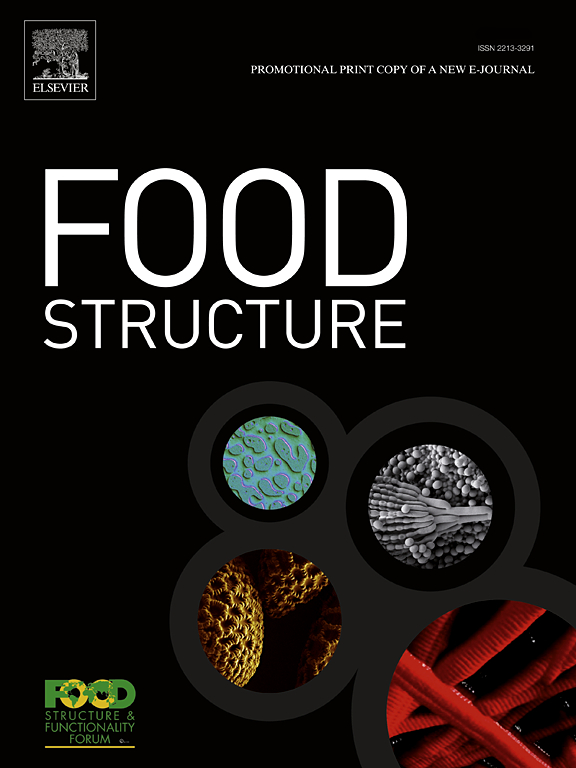How differences in rice texture and oral physiology affect sensory preference and eating behavior of consumers: A generalized additive models (GAMs) approach
IF 5.9
3区 农林科学
Q1 FOOD SCIENCE & TECHNOLOGY
引用次数: 0
Abstract
Both food texture and human oral physiology impact consumer preferences and eating behavior. However, the complex relationships between these factors are difficult to explain using simple mathematical models. For this reason, the potential of a generalized additive model (GAM) to relate food texture to oral physiology during the development of healthier foods was investigated. This semiparametric model combines the advantages of both parametric and nonparametric models. The oral behavior of a modified Japonica rice (JM), a low glycemic index (GI) food rich in resistant starch, was compared to that of regular Japonica rice (JR). Both JM and JR were cooked at three water-to-rice (W/R) ratios (low, recommended, high) to obtain samples with different textural properties. The oral physiological parameters of seventeen participants were measured, including biting force and saliva properties. Furthermore, time-intensity (TI) analysis, video recording and electromyography (EMG) were used to provide multiple dynamic sensory analyses. JM required more chewing cycles and longer chewing durations than JR, due to its firmer textural attributes. Linear GAM analysis demonstrated that high hardness and low stickiness of rice led to more chews, chewing duration, and muscle activities, raising the oral processing load and lowering consumer overall liking scores. Additionally, nonlinear GAM analysis indicated that average saliva flow rate and mucin concentration were negatively correlated with both chewing frequency and duration. A simulated gastrointestinal model showed that JM was digested more slowly than JR. In summary, this study provided valuable insights for optimizing the sensory attributes of high-resistant starch rice to enhance its palatability and consumer acceptance.
大米质地和口腔生理的差异如何影响消费者的感官偏好和饮食行为:一种广义加性模型(GAMs)方法
食物质地和人体口腔生理都会影响消费者的偏好和饮食行为。然而,这些因素之间的复杂关系很难用简单的数学模型来解释。因此,在健康食品开发过程中,研究了广义加性模型(GAM)将食物质地与口腔生理联系起来的潜力。该半参数模型结合了参数模型和非参数模型的优点。研究了一种富含抗性淀粉的低血糖指数(GI)食物——改良粳稻(JM)与普通粳稻(JR)的口服行为。将JM和JR在三种水米比(低、推荐、高)下煮熟,得到具有不同质地特性的样品。测量了17名参与者的口腔生理参数,包括咬合力和唾液特性。此外,时间强度(TI)分析、视频记录和肌电图(EMG)提供了多种动态感觉分析。JM比JR需要更多的咀嚼周期和更长的咀嚼时间,因为它的质地更坚固。线性GAM分析表明,高硬度和低粘性的大米导致更多的咀嚼,咀嚼时间和肌肉活动,增加了口腔加工负荷,降低了消费者的整体喜欢得分。此外,非线性GAM分析表明,平均唾液流速和粘蛋白浓度与咀嚼频率和持续时间呈负相关。模拟胃肠道模型显示,JM的消化速度比JR慢。总之,本研究为优化高抗性淀粉大米的感官属性以提高其适口性和消费者接受度提供了有价值的见解。
本文章由计算机程序翻译,如有差异,请以英文原文为准。
求助全文
约1分钟内获得全文
求助全文
来源期刊

Food Structure-Netherlands
Chemical Engineering-Bioengineering
CiteScore
7.20
自引率
0.00%
发文量
48
期刊介绍:
Food Structure is the premier international forum devoted to the publication of high-quality original research on food structure. The focus of this journal is on food structure in the context of its relationship with molecular composition, processing and macroscopic properties (e.g., shelf stability, sensory properties, etc.). Manuscripts that only report qualitative findings and micrographs and that lack sound hypothesis-driven, quantitative structure-function research are not accepted. Significance of the research findings for the food science community and/or industry must also be highlighted.
 求助内容:
求助内容: 应助结果提醒方式:
应助结果提醒方式:


